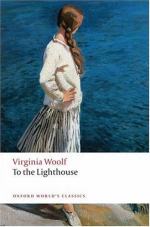|
This section contains 5,408 words (approx. 19 pages at 300 words per page) |

|
SOURCE: “Tables in Trees: Realism in ‘To the Lighthouse,’” in Studies in the Novel, Vol. 16, No. 4, Winter, 1984, pp. 424–434.
In the following essay, Bassoff argues that in To the Lighthouse realism is centered on individual sight and experience.
Toward the beginning of To the Lighthouse, young James Ramsay, sitting on the floor cutting out pictures from an illustrated catalogue, endows one of the pictures with all the “heavenly bliss” he feels as his mother speaks.1 As the child is father to the man, moments like these are the prototypes of the Woolfian epiphany or spot of time: the moment when some consciousness—either dramatized within the text or implied by the text—transcends its usual limitations by transcending the usual appearances of the world. Cézanne once made a famous remark that painting from nature is not copying the object but realizing one's sensations. For that reason, as Robert...
|
This section contains 5,408 words (approx. 19 pages at 300 words per page) |

|


